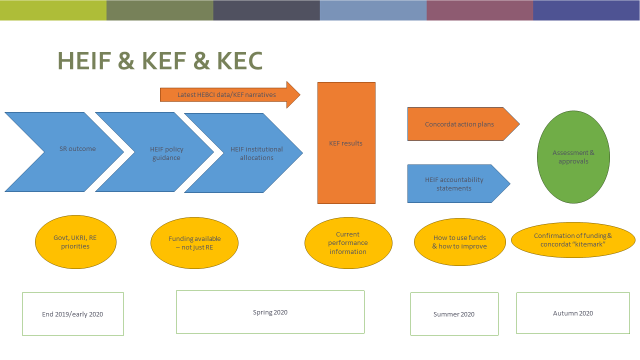Alice Frost, Director of Knowledge Exchange at Research England, blogs about today's launch of the KE Concordat (KEC) as the latest initiative from the university sector responding to challenges set by the Government's Industrial Strategy and the 2.4% R&D target.
Recently there have been multiple discussions about the relationships between multiple different acronyms. The latest 'kid on the block' is KEC - the Knowledge Exchange Concordat - which is published today. This has been developed by a group led by Professor Trevor McMillan, Vice-Chancellor of Keele University, supported by Universities UK and Research England and with contributions from several members of PraxisAuril.
How do the metrics we in Research England are developing for the Knowledge Exchange Framework (KEF), fit with the KEC? And how do both these link with our funding for knowledge exchange through Higher Education Innovation Funding (HEIF)? A Government Spending Review should occur shortly. As well as setting funding for future years, the spending review will confirm key Government priorities, which we will need to address in allocating HEIF. This will be achieved through us publishing a statement on our KE policies, and a request for universities to provide us with appropriate information in response (HEFCE circular 2016/16 provides a model). In Research England, we are already thinking ahead about how we may implement another funding round, taking into consideration new developments such as KEF and KEC.
We allow universities significant flexibility in their use of HEIF formula allocations. This is because we achieve our aims of delivering economic and societal impacts through universities focussing relentlessly, and with agility, on their external partners –businesses, investors, entrepreneurs and local, public and third sector bodies. But to be secure in provision of flexible public funding, we need assurance from universities that they have in place sound overall KE strategies and management systems, including continuous improvement measures. This ensures that our funding will be used efficiently and effectively. We have sought this assurance in past rounds of HEIF by requesting and approving institutional KE strategies.
The world has moved on significantly since HEFCE 2016/16 was implemented. The Government challenged us all in the Industrial Strategy that university performance in knowledge exchange would need to improve. This was not due to poor performance, as UK standards calibrate well with overseas comparators. It was due to the weight of expectation placed on universities as key agents to deliver the strategy, including now the 2.4% target.
KEF and KEC are both part of the response to the Government’s challenge. KEF and KEC – alongside our funding for KE through HEIF – aim to provide an overall schema for how to achieve higher university KE performance in the future. The key elements are:
- Provision of objective comparison and calibration information on performance, as the basis for institutional self-assessment - the KEF has a role here
- Attention by institutions to the key principles and best practices that underlie high performance – the Concordat provides these
- Use of available resources to focus on these areas of strength and opportunities for improvement – where HEIF plays a part
There is an opportunity from the KEF-KEC-HEIF equation both to focus more intensively on the Government’s improvement challenge, and to manage burden on universities sensibly.
The information provided in KEF, and the commitment of universities to sign up to and implement the Concordat, should go a long way to providing us with the assurance we need on sound, overall institutional KE strategy and management. KEF aims to provide information on strengths and weaknesses of performance. The KEC should spur universities to undertake a gap analysis against its principles and enablers. The publication of resulting KEC action plans, and their examination by an independent panel including external users, should give strong evidence of the commitment of the university sector to seek to improve further, against already high standards.
We expect then to be able to reduce the information we request on institutional KE strategy, shifting our attention specifically to uses of HEIF. Shorter statements on accountability for HEIF should give us evidence that funds are used for purposes intended. These should also provide important spending review evidence - that HEIF is vitally needed to address real opportunities, challenges and demand pressures.
We have said that we aimed to undertake a next HEIF cycle in 2019-20, with a view to these dovetailing into the end of the last period of KE strategies (strategies for 2016-17 through to 2020-21). Delay to the Spending Review may have implications for our implementation timetable (though we will of course ensure time for universities to produce high quality responses). Our current timetable for implementation is set out below:

We encourage universities, then, to engage with today’s consultation on the KE Concordat. We see the Concordat as complementary to the KEF and a critical component to making the case that universities are addressing key Government priorities and will deliver value from future public funds.
Alice Frost, Director of Knowlege Exchange, Research England